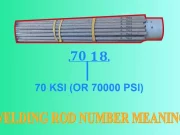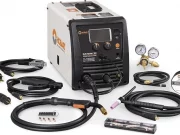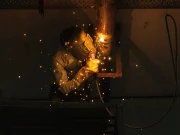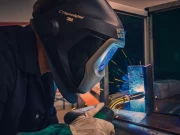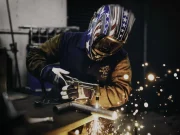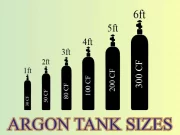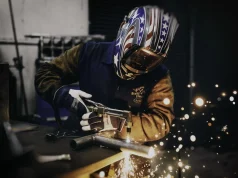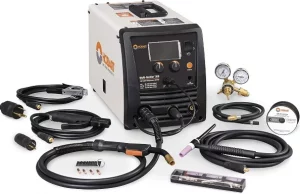Are you looking for tips on how to weld aluminum with a stick welder? If yes, then you have come to the right place. Usually, stick welding is notable for welding iron and steel. But if you are conversant with how to use it, you can also weld aluminum with great result. Alright, let’s get down to business.
How you can weld aluminum using a stick welder
Let’s run through how you can stick weld aluminum. Firstly, you need to get your flux-coated aluminum electrode ready, prepare the base metal, set the current and polarity on the welding machine right and start welding. Use DC reverse polarity (the electrode will be positive while the base plate is negative). You also need to consider preheating the base metal before you think of striking an arc. Furthermore, preheating can make slag cleaning a breeze and help avoid weld cracking.
So, that’s it about how you can weld aluminum, but there’s more you need to know. Keep reading
Stick Welding Aluminum: Things You Need To Know
Before now, it was evident that the TIG welding process was the most popular means of welding aluminum. It was cheap though a bit slow to deploy. But things have changed in recent times. Now, other welding methods can get the job done. This includes MIG and Stick welding processes.
The MIG and Stick aluminum welding processes have a simple learning curve. In short, you don’t even need any training to achieve quality welds. Just a few guidelines or going through the right information can help you stick or MIG weld your aluminum material and produce a sound weld.
However, to achieve a sound weld, you need to have the right information. That is, you need to understand things like the properties of aluminum, the aluminum electrode to choose (based on the material thickness), ideal current and polarity setting, and preheat temperature (that is if you plan to preheat), among other details.
Let’s go through some tricks and tips that will enable you to understand and stick-weld aluminum. These are things you need to have in mind before you even consider striking an arc.
- You need to have a DC stick welder. It works great for welding aluminum.
- Aluminum tends to form a protective layer of aluminum oxide once it reacts with the oxygen present in the air. So, before you start welding, you need to ensure this protective layer (2-3 nanometers in thickness) is removed. You can clean this layer off with sandpaper or a sharp tool.
- When stick welding aluminum, you need an aluminum electrode (based on the thickness of the material you are welding). On the product package, you will find the details, indicating what the electrode current range is, rod diameter, and whether it’s a DC only electrode positive (DCEP) or not.
The flux coatings on these electrodes are different from what you will find on the commonly used steel electrodes. Nevertheless, the process is the same.
- Excitingly, stick welding is somewhat rapid. It also doesn’t require much training to start welding aluminum with a stick welder. All you need is to understand the little details and follow the procedure to get a sound weld.
Another thing that characterizes this welding process is that the metal usually does not have physical contact with the arc that much. You will notice this when you start welding.
- When welding aluminum, it is paramount to use a flux coated electrode together with DC reverse polarity. Furthermore, similar to when one MIG welds aluminum, the DCEP makes an equal contribution.
The DCEP continuously gets rid of the oxide layer, away from your base metal. The electrode flux helps to prevent the formation of oxides over the electrode metal, including the molten pool.
| NOTE: The flux coating does a great job when stick-welding aluminum. It protects your welds as it cools down, thus forming a protective layer over it. And this makes it possible to weld even in a breezy condition. |
- There are different types of electrodes, so the polarity and current setting on the welder depends on the electrode type. However, you can try to determine the ideal polarity by conducting a trial on the specific joint you intend to create.
- You need to understand that these DC (direct current) flux-coated electrodes can’t function when you are making use of an AC (alternating current) output stick welder. What’s the reason? The arc would extinguish when the sine wave hits the zero voltage portion.
- It is a bit challenging to control the arc. And for that same reason, fillet and butt welds are difficult to produce, particularly in a plate that is lower than 1/8 inch thickness.
Well, these are some of the tips you need to know if you are planning to stick weld aluminum. As earlier said, knowing the little details will enable you to produce quality results.
However, there are drawbacks in welding aluminum using a stick welder. The thing is the process isn’t that challenging to get started with, but the issue is the appearance and quality of the welds. It might take a while for you to get a sound weld.
Besides trying to get to that level when you can start delivering quality welds, the slag cleaning and cost of welding aluminum with a stick welder are also part of the drawbacks. Another challenge is how to control the arc. It is a bit challenging, but you can get used to it anyway, maybe after a couple of welds.
Well, I understand most welders who have AC TIG welding set-up may ridicule the process of using a stick welder to weld aluminum. But if this is the only means you have and need to complete your project as quickly as possible, then you have no option but to use it.
Aluminum And Properties: Things You Should Know
Understanding the properties of aluminum would make it much easier and straightforward for you to utilize a stick welder and achieve your desired results. So, before we talk about other aspects of the stick welding process, let’s go through some of the properties of aluminum.
Firstly, aluminum is a breeze to weld and join with other metals. The pure aluminum metal is soft, though it can become harder and stronger when alloyed. On ductility, aluminum is one of those metals that you can conveniently beat to form a thin sheet. In other words, it is ductile. It also has a low density and melting point.
Aluminum is a valuable metal, widely used in the welding and fabrication industry, the world over. It can be used to fabricate complex structures and commonly deployed in the automotive sector. It is also a lightweight metal, weighing 2.7 g/cm3 (lighter than steel). Thus, the cost of using aluminum for various fabrications is lower.
Unlike steel, when aluminum reaches its melting point, there will be no visible color change. But then, once it exceeds the melting point, the red color (quite dull though) becomes apparent. However, most of the welding procedures and welders don’t allow aluminum to get to the stage where it would exceed the melting point. That’s why after welding; the color of the metal usually remains intact.
Furthermore, is aluminum a good conductor of heat? The answer is yes. Nevertheless, you may need to increase the heat settings to weld aluminum, compared to other metal types. The heat required varies according to the thickness of the aluminum that you are planning to weld.
Again, keep in mind that the high heat conductivity makes it possible for the metal to solidify faster.
So, is preheating necessary? Yes, it is. If you are going to weld thicker aluminum, you need to preheat to a certain degree. It makes it a breeze to clean off the slag from the base metal after you finish welding and can help prevent cracking.
Naturally, aluminum can generate a protective layer (a thin oxide coating) to keep it from having contact; particularly with the environment they are kept. This helps to combat corrosion and makes aluminum useful for several applications where it would be exposed to agents that cause corrosion.
Now, how does aluminum forms this protective oxide coating? The oxide coating is formed when there is a reaction between pure aluminum and the oxygen present in the air. The reaction creates a tiny barrier oxide layer over the surface of the metal. This barrier oxide layer is called the aluminum oxide and is between 2-3 nanometers in thickness.
| NOTE: Aluminum alloy is less resistant to corrosion than pure aluminum. However, you can improve this corrosion-resistant property through a series of surface treatment. These include anodizing, lacquering or painting. |
Conclusion
If you are interested in knowing how to weld aluminum with a stick welder, then you will find this post useful. Using a stick welder is not the only option you can use to weld aluminum. It is even more expensive compared to using the AC TIG welding process. But if you understand how to use a stick welder in the right way to weld aluminum, you will develop more interest in it.




